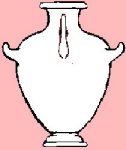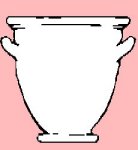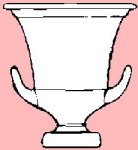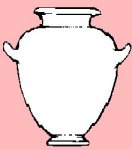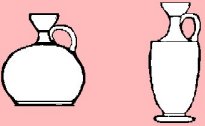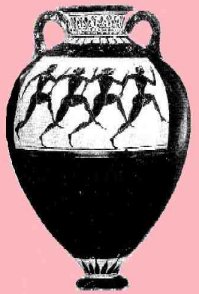Athenian painted pottery
Classification of shapes
Storing Wine |
||
 |
Both types of amphora were used for "decanting" the wine that would be used for the symposium. Long term storage was in much larger jars called pithoi. |
 |
| Amphora | Pelike | |
For water |
Serving |
|
|
Hydria |
The typical red-figure style of hydria (earlier styles were more like a large jug) were used for the water that was to be mixed with the wine - it was often heavy, hence the three handles: it was a two-person job. This is not what would be used for fetching the water from the fountain-house or well. |
Oinochoe or Jug |
For mixing wine and water |
||
|
Bell Crater |
The various styles of Crater would be where the drink would be served from, once the wine and water had been mixed to the agreed proportions. It would be served into the cup using a jug or oinochoe - the Stamnos was designed to be used with a ladle or dipper. |
Volute Crater |
|
Column Crater |
Calyx Crater |
Stamnos |
For drinking from |
||
|
Cup or Kylix |
Kantharos |
Skyphos |
|
The kylix was designed for playing kottabos, where the dregs of the wine would be expertly flicked, at a target, or another player. The kantharos is obviously based on metal versions. The skyphos is often huge - a cup for the serious drinker! |
||
Womens' quarters |
||
|
Epinetron |
Loutrophoros |
|
|
Pyxis |
The Epinetron was a thigh-protector used buy a woman when roving the wool - it was to prevent the grease spoiling her clothes. There were many types of pyxis, which would typically be used for jewellery or small items. The Loutrophoros was used for the special water used in the bridal bath. For details see here. |
|
Used for Oil |
||
|
Alabastron |
The alabastron could be used for perfumed oil, which would be used during love-making (see Aristophanes' Lysistrata). The presence of one in the backgound in a vase painting usually suggests that sex is on someone's mind! The aryballos would be used for carrying around one's daily supply of oil - attached to the belt. This is the lekythion in the Frogs of Aristophanes featured in the "lost his bottle of oil" scene. The right-hand lekythos was specifically used for tomb offerings - some were painted in colour on a white backgound, because they would not be subject to wear and tear underground. |
Aryballos |
|
Lekythoi |
||
|
Panathenaic Amphora |
The Panathenaic Amphora was a prize, or part of one for a winner at the Panathenian Games in August each year. Strictly the prize was the olive oil the amphora contained - but there is evidence that winners treasured the actual vases. They always show Athena on one side, and a depiction of the event on the other. The shape is very distinctive - small handles and narrrow base. Traditionally they continued to used the black figure technique for decoration for centuries after it was obsolete elsewhere. They were of course very large. |
|

